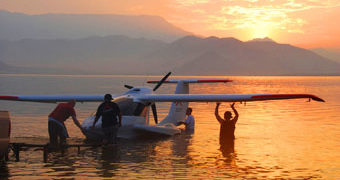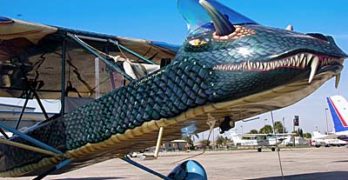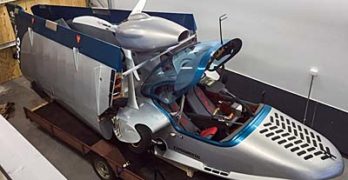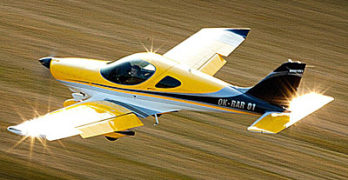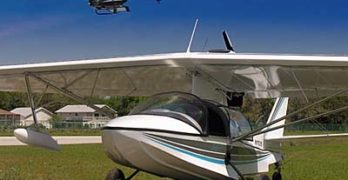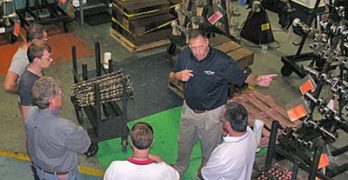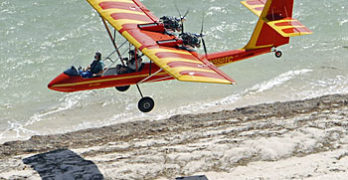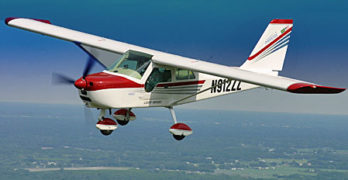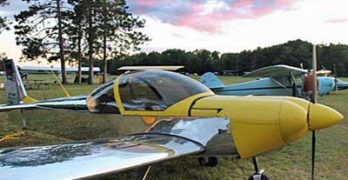On this website, we zoom around the world following Light-Sport Aircraft, from near the Arctic Circle — you know, where Santa and the wee elves are pulling some heavy overtime about now — to the warm balminess of Southern California. I know of what I write, having once lived in the snow belt and now hanging with the family in Palm Springs, California for Christmas. It seems everywhere I look I see LSA seaplanes in sea trials and this is happening in the dead of winter.
Why be surprised? Perhaps you’ve noticed boat shows happen in the winter months. When living in Minnesota, I was always amazed that boat shows were held in January and February, a time of year when it would be months before the ice melted from the state’s 10,000 lakes to allow use of those boats. Yet this is when people were shopping, I suppose anticipating an upcoming season of boating fun.
Search Results for : flight design ct
Not finding exactly what you expected? Try our advanced search option.
Select a manufacturer to go straight to all our content about that manufacturer.
Select an aircraft model to go straight to all our content about that model.
Fun, Powerful, Gnarly … that’s AirCam
What would you like for a Christmas present, perhaps if you won big in a lottery? Well, you’re a pilot so I might guess that some airplane has caught your fancy. Me, too. Like most pilots a number of desirable airplanes catch my eye but also like most pilots, I cannot afford to have one of each that appeals to me. High on my list of wished-for airplanes is Lockwood Aircraft‘s Air Cam. I have quite a few hours flying one example or another. I even earned my multiengine rating in one, as part of an article I wrote years ago.
As part of the required hours of training to take the flight check — no written test is involved for a multiengine rating — I engaged an old friend and multiengine instructor, Richard Johnson. An Air Cam owner, Sebring dentist Ron Owen, graciously supplied his Air Cam.
Finland’s Atol Amphib Begins Water Tests
Ah, the Christmas season is soon upon us (or already is judging by familiar music playing on every speaker you hear). It sounds like a great time to go put your new seaplane in the water … especially if you live up by the Santa Claus toy workshop. Wait a minute! Can that be right? Yup! Atol Avion Ltd., recently notified us, “We have finally performed first water taxi tests of our production prototype on December 14th, 2014 at Rovaniemi, Finland. After thorough systems tests, water taxi tests were performed on Kemijoki River near the Arctic Circle … just a few miles from Santa’s home. Our plane worked as planned and proved to be even better than expected.”
As a Florida resident, I have plenty of local acquaintances that think such an exercise sounds crazy, to be out water testing an amphibious airplane in winter. They mean here in Florida where it’s on the cool side … you know, 50s and 60s.
BRM Aero’s Bristell Gains New U.S. Distributor
BRM Aero‘s Bristell got off to a good start in the USA two years ago. Unfortunately, after an initial burst of positive reviews and good response from pilots, the distributor at the time stumbled. A failed association with the now-defunct Aviation Access Project undermined the efforts but that association had nothing to do with the Czech aircraft producer. So, after a year or so of discussions and evaluation, BRM Aero found a new, high-quality representative.
In early December 2014, Bristell Aircraft, a New York corporation, officially accepted the appointment to represent the aircraft of BRM Aero. “Bristell Aircraft is an American company whose roots go deep into the highly-structured world of FAA-certified aircraft,” said Lou Mancuso, director of Bristell Aircraft. Over the last year, Lou has worked directly with BRM Aero “to develop, customize, and standardize aircraft specifically for the North American market.” Lou and his team bring 68 years of aviation sales, service and training success and appear well suited to the endeavor.
Fresh American LSA & Ultralight Exports
Wait! “…Exports?” I realize that might look like a typo. Did I intend to write LSA imports? Nope, exports is the correct word. Back in the early days of Light-Sport Aircraft, circa 2005-6-7, the source countries manufacturing the LSA people were buying were of a high percentage European with the Czech Republic leading the charge. Their penetration of the market was approximately two-thirds of all LSA. Then came the global economic recession, which happened as the industry began to mature. All were affected: domestic and international companies and pilot consumers. Some handsome imported aircraft never found a market.
In any downturn, some managers adapt quicker to the changing economy. They find a way to offer new aircraft to keep the momentum. Neither were American companies sitting on their thumbs. European builders had a head start because the European-style ultralights they had been manufacturing were close to what FAA allowed as LSA, so many models could be rapidly adapted to meet the Yankee marketplace.
Working Aircraft … for the Fun of Flying
In two industry meetings held during 2014, Light-Sport Aircraft manufacturers, organization leaders, FAA personnel, and other interested parties reviewed a list of changes that would improve the 10-year-old SP/LSA regulation. Some items represent minor changes the agency could make fairly quickly. Others are more challenging. Number one on the list involves FAA allowing certain commercial LSA operations when flown by qualified pilots. Even if no great resistance exists — and reasons for optimism are present — this could be some time coming as regulation change is complicated in today’s federal government. Another area of intense interest is electric power. While unleashing development of LSA using electric propulsion also requires regulation change, an exemption might allow technical progress before rule change could occur. Recently another group with many more years of effort already invested was able to earn such an exemption. Ed Pitman of Pitman Air recently announced Exemption 11104.
Touring Aviation Stalwart Continental Motors
Continental Motors is known to generations of pilots and not just in the USA. However, I’ll bet most readers do not know that the storied company once produced a radial engine. The company started business way back in 1905 as a builder of truck engines for the U.S. Army. They entered the aviation market in 1929 with the seven cylinder A-70 powerplant. A year later Continental introduced A40 that went to four horizontally opposed cylinders in what is sometimes called a boxer engine. “We were the first to introduce the horizontally opposed cylinder configuration to help increase aircraft speeds,” observed the company. Rotax has generated well deserved publicity with their efficient fuel injected 912 iS but Continental noted that they were “the first to introduce both fuel injection and turbo-charging in general aviation aircraft (both in the 1960s).” They do not offer such configurations for Light-Sport Aircraft, at least not yet although in 2009 Continental threw support behind the new segment introducing the O-200 lighter weight engine that comes in at 199 pounds.
AirCam Owners Know How to Have Fun
I’ve been on a couple AirCam outings and I have two points about them: (1) Owners of this unusual airplane are often fairly well-off people and see a golden opportunity when invited by the good planners at Lockwood Aircraft; and, (2) These pilots know how to have fun with their airplanes, flying to some delicious locations. Previous fly-outs included Jekyll Island, Heaven’s Landing, Cedar Key off Florida’s west coast, and the Bahamas. If you don’t know AirCam here’s a video that gives a bit of the flavor of this amazing aircraft. (I readily admit to a positive bias for the machine as I have had the chance to fly a good number of hours in it and earned my multi-engine rating in one … but that’s another story.)
On the two occasions when I’ve joined the AirCam’ers on their fly-outs (or is that “fly-ins?”), I’ve discovered that these folks have uncovered some wonderful places.
P1NG … Fully Refreshed from Brazil
P1NG is not a sound nor golf equipment. The clever name (that’s a “1” not an “i”) is similar to a plane you know as the Paradise P1. Now get ready for the “Next Generation” P1, or simply, P1NG. The P1 you may have already seen was designed around a four-seat model with the aft cabin simplified to a luggage space. More on the entire family of Paradise airplanes below. P1 and P1NG offer more cubic area than most cockpits in light aviation. Besides a spacious cabin the front seats remove in a few seconds allowing an occupant to stretch out fully in its length. Alternatively, P1NG could easily carry golf clubs (you probably ought to load the American Ping brand), a family pet, camping gear, or anything else that fits within the weight & balance envelope. Though absent from the U.S. market for several years, Paradise reports good business in their native Brazil, a large and aviation-active country.
Corvair Power at Zenith’s Open Hangar Day
Zenith Aircraft has shipped thousands of airplane kits and have examples of Chris Heintz designs flying all over the country and around the world. The kit company run by Chris’ son Sebastien has been at it nearly a quarter century in Mexico Missouri and in my humble opinion deserves the success they’ve achieved by operating the business professionally and by serving their customers well. Two of the many ways this happens is through their Open Hangar Day event — which they’ve hosted since moving to Mexico — and by supporting just about every powerplant aimed at the light recreational aircraft market. Recently I wrote about Viking engines and I’ve often written about Rotax, Jabiru, Continental, and UL Power. One that I’ve left out of the review has been William Wynne’s Corvair-based powerplant and I am pleased to correct that oversight.
- « Previous Page
- 1
- …
- 82
- 83
- 84
- 85
- 86
- …
- 145
- Next Page »


